DACF Home → Bureaus & Programs → Maine Geological Survey → Explore Maine Geology → Maine's Surficial Geology → Surficial Geologic History of Maine
Surficial Geologic History of Maine
Approximately 120 million years passed between the formation of the youngest bedrock in Maine and the Pleistocene Epoch, popularly known as the "Ice Age." There is little evidence of the weathering and erosion of the land that occurred during this long interval, though remnants of deeply weathered and disintegrated bedrock that escaped later erosion by glacial ice can be seen in places.
Continental glaciers similar to today's Antarctic Ice Sheet probably extended across Maine several times during the Pleistocene Epoch, which lasted from about 2.5 million to 10,000 years ago. The slow-moving glacial ice changed the landscape as it scraped across mountains and valleys (Figure 1), eroding rock debris and carrying it for miles (Figure 2). The sand, gravel, and other unconsolidated sediments that cover much of Maine are largely the products of glaciation. Some of these materials were deposited directly from glacial ice as an uneven blanket of stony till; others washed into the sea or accumulated in meltwater streams and glacial lakes as the ice receded. Glaciation also disrupted earlier drainage patterns and helped create the hundreds of modern ponds and lakes scattered across the state.
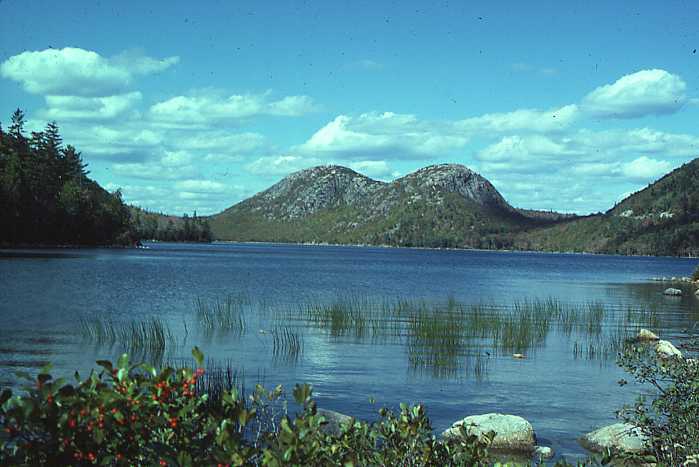
Figure 1. "The Bubbles" and Jordan Pond in Acadia National Park. These hills and valleys were sculpted by glacial erosion. The pond was dammed behind a moraine ridge during retreat of the ice sheet.
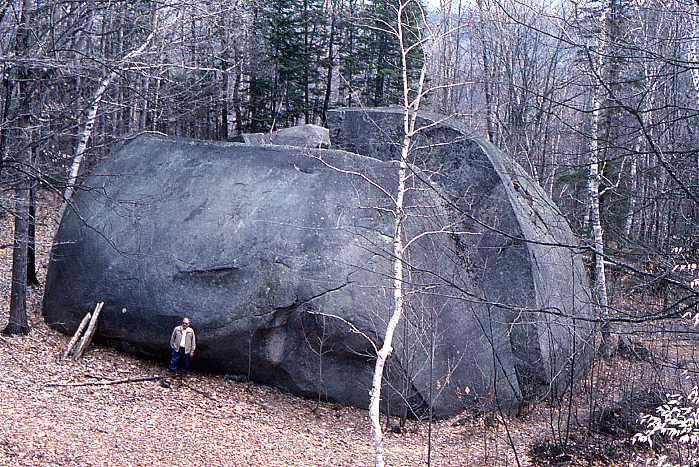
Figure 2. Daggett Rock in Phillips. This is the largest known glacially transported boulder in Maine. It is about 100 feet long and estimated to weigh 8,000 tons.
Most glacial activity in Maine involved large continental ice sheets, but the erosional effects of alpine glaciers are clearly evident in two of the highest groups of mountains: Mt. Katahdin and neighboring peaks in Baxter State Park, and Sugarloaf Mountain and other nearby peaks in western Maine. Local glaciers eroded deep semi-circular bedrock basins (cirques) high on the flanks of these mountains. The basins on the east side of Mt. Katahdin are the best-known examples (Figure 3; Caldwell, 1972).
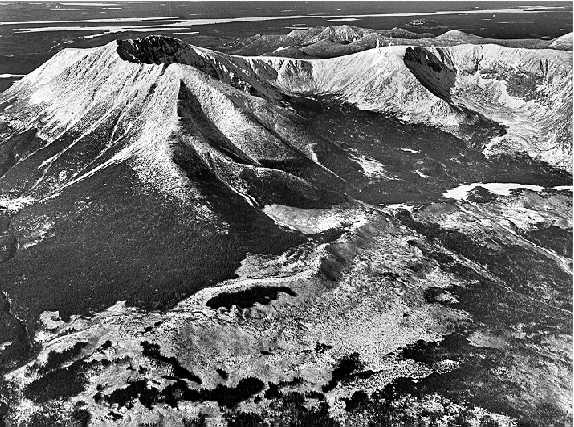
Figure 3. Aerial view of glacial cirque basins on Mt. Katahdin (top and upper right). The low, sinuous, snow-covered ridge trending across the foreground is the Basin Ponds Moraine.
The most recent glacial episode in Maine began about 35,000 years ago, when the Laurentide Ice Sheet overspread southern Quebec and New England. During its peak development, this ice sheet was centered over eastern Canada and flowed east to southeast across Maine. It became several thousand feet thick and covered the highest mountains in the state. The weight of the glacier pushed the land downward several hundred feet.
Rock debris was eroded and incorporated into the base of the glacier, causing the ice to abrade the bedrock surface over which it flowed. The grooves and fine scratches (striations) resulting from this process are often seen where bedrock has been freshly exposed (Figure 4). They are important in determining the directions of former ice movement. Erosion and sediment deposition by the ice sheet combined to give a streamlined shape to many hills, the long axes of which are parallel to ice flow. Some of these hills (drumlins) are composed of compact glacial sediment (till) plastered under great pressure beneath the ice.
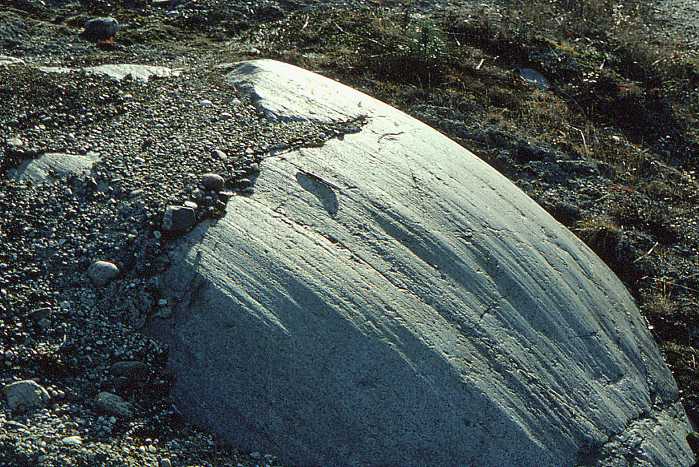
Figure 4. Granite ledge in Westbrook, showing polished and grooved surface resulting from glacial abrasion. The grooves and shape of the ledge indicate ice flow toward the southeast.
Climatic warming forced the Laurentide Ice Sheet to start receding as early as 21,000 years ago, soon after it reached its terminal position on Long Island, New York (Sirkin, 1986). The ice margin withdrew from the Gulf of Maine to the present position of the Maine coast by 17,000 to 16,000 years ago (Borns and others, 2004). The Earth's crust was still depressed by the weight of the ice sheet, causing the sea to flood southern Maine as the glacier retreated to the northwest. Figure 5 shows this "highstand" of relative sea level, which occurred when global sea level was actually lower than today (because so much water was still tied up in glaciers).
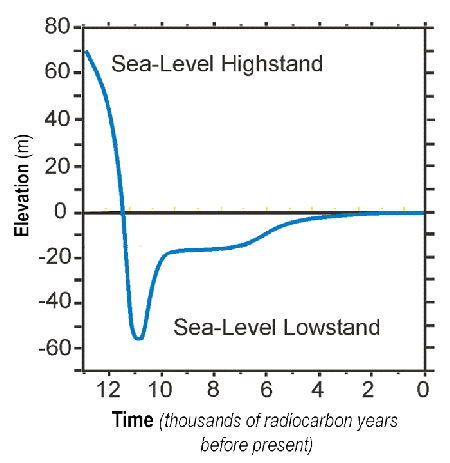
Figure 5. Plot of relative sea level in coastal Maine vs. time, showing the rapid drop in sea level in late-glacial time. This resulted from uplift of the Earth's crust after the weight of the ice sheet was removed. In more recent millennia, sea-level rise has become dominant due to continued melting of the world's glaciers. Note that the time scale on this graph is expressed in radiocarbon years (see text). Modified from Dickson (1999).
The landforms and sedimentary deposits resulting from marine submergence are among the most distinctive glacial features in the state. The sea extended far up the Kennebec and Penobscot valleys, reaching present elevations to at least 420 feet in the central Maine. Great quantities of sediment washed out of the melting ice and into the sea, which was in contact with the receding glacier margin. Sand and gravel accumulated as deltas and submarine fans where streams discharged along the ice front (Figure 6), while the finer silt and clay dispersed across the ocean floor (Figure 7). The marine environment favored accumulation of till and washed sediments in ridges (moraines) along the bottom edge of the glacier margin (Figure 8). Moraines commonly form clusters in which the individual ridges are closely-spaced and mark successive positions of the ice margin (Figure 9).

Figure 6. Glaciomarine delta in Franklin, formed by sand and gravel washing into the ocean from the glacier margin. The flat delta top marks approximate former sea level. Kettle hole in foreground was left by melting of ice.
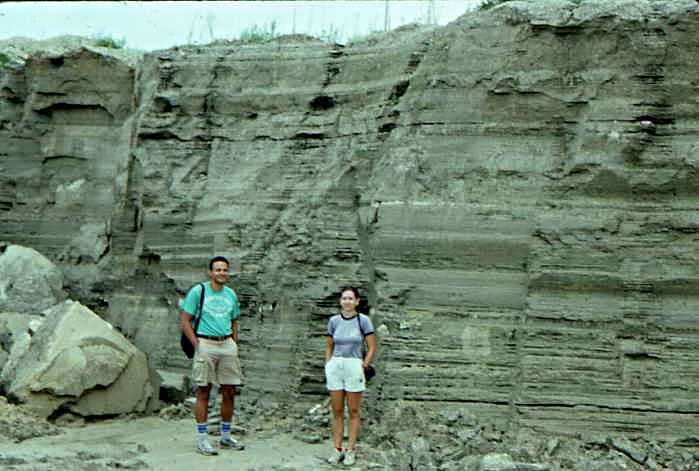
Figure 7. As the glacier receded, seawater flooded low-lying areas. Muddy sediments settled on the ocean floor forming a deposit called the Presumpscot Formation. Layered Presumpscot silts and clays are seen in this exposure in the Pleasant River valley near Windham Center.
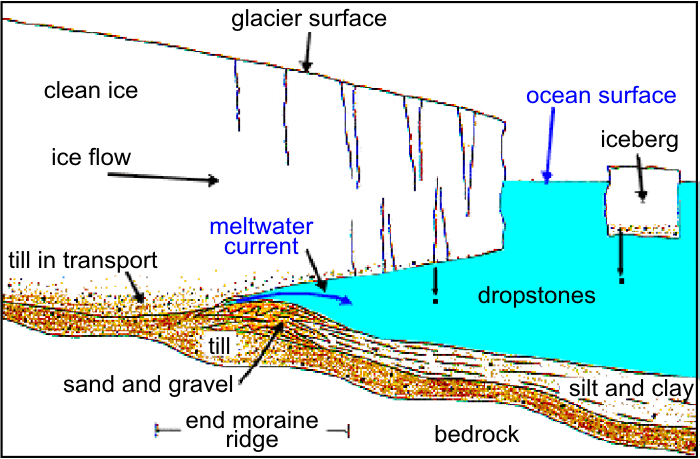
Figure 8. Schematic cross section of the glacier margin in coastal Maine, showing formation of a moraine ridge where the edge of the ice sheet was in the sea. This moraine consists of till interlayered with sand and gravel washing out of the ice. From Thompson (1982).
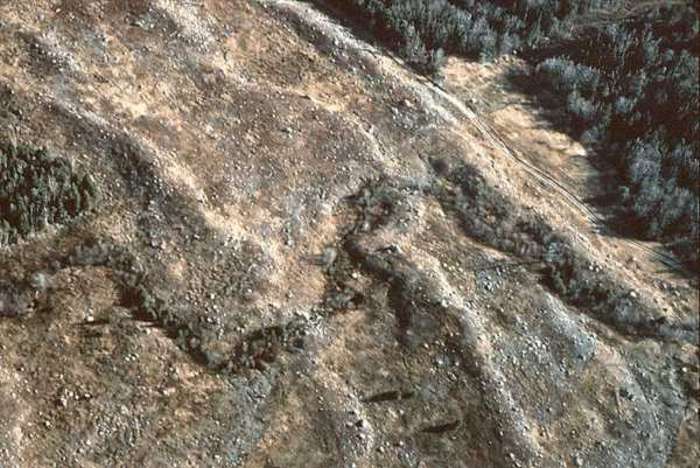
Figure 9. Aerial view of moraine ridges in blueberry field, Sedgwick (note dirt road in upper right for scale). Each bouldery ridge marks a position of the retreating glacier margin. The ice receded from right to left.
Shells of clams, mussels, and other invertebrates are found in the glacial-marine clay that blankets lowland areas of southern Maine. The ages of these fossils can be determined by radiocarbon dating, although the laboratory ages in "radiocarbon years" must be adjusted to determine their equivalents in calendar years. For late-glacial time, calendar ages are about 2,000 years older than radiocarbon ages. Age determinations from numerous fossil localities tell us that the marine submergence lasted until about 13,000 years ago, when it was terminated by uplift of the Earth's crust as the weight of the ice sheet was removed.
Some of the glacial sand and gravel was deposited by meltwater streams in tunnels within the decaying ice. These deposits were left behind as ridges (eskers) when the surrounding ice disappeared (Figure 10). Maine's esker systems are among the largest in the country; they can be traced for up to 100 miles. Other waterlaid glacial deposits formed adjacent to melting ice in areas above the marine limit. They include deltas built into temporary ice-dammed glacial lakes and muddy sediments on lake bottoms. Many of these waterlaid deposits are well stratified (Figure 11), in contrast to chaotic mixtures of boulders and sediment of all sizes (till) released from dirty ice without subsequent reworking (Figure 12).
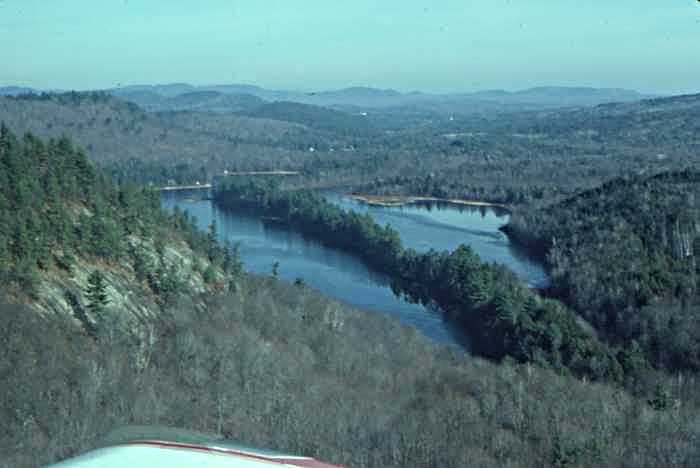
Figure 10. Esker cutting across Kezar Five Ponds, Waterford. The ridge consists of sand and gravel deposited by meltwater flowing in a tunnel beneath glacial ice.
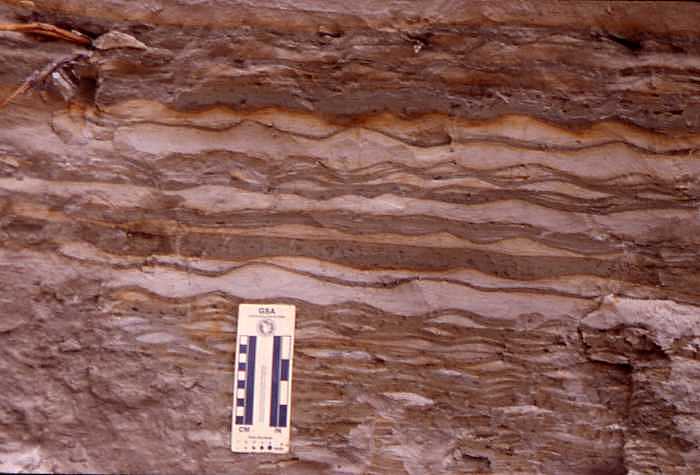
Figure 11. Layers of sand and silt deposited in a glacial lake, Bridgton.
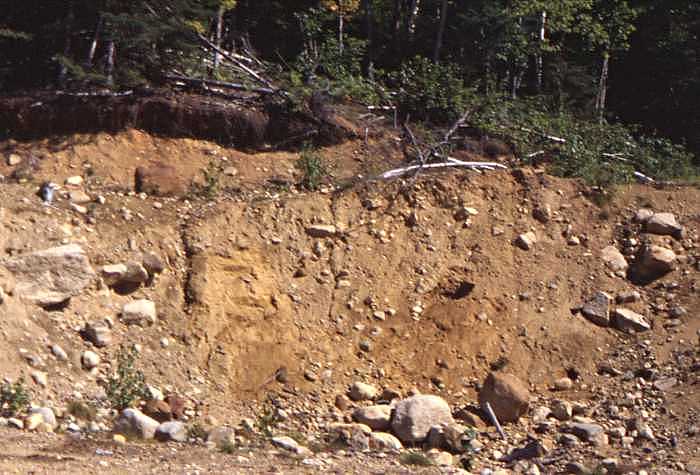
Figure 12. Till exposure in pit south of Bad Mountain in Albany.
By 13,000 years ago the glacier had shrunk to a local ice mass covering northern Maine and parts of neighboring Quebec and New Brunswick (Thompson and Borns, 1985; Borns and others, 2004). This local ice had been cut off from the Laurentide Ice Sheet in Canada by encroachment of the sea up the St. Lawrence River valley. The residual ice cap developed a new flow pattern such that ice in northernmost Maine actually flowed back toward Canada. There may have been a brief expansion of the ice cap during a cold climate episode called the "Younger Dryas," between 13,000 and 11,500 years ago.
The last remnants of glacial ice probably were gone from Maine by about 11,000 years ago. Large sand dunes accumulated in late-glacial time as winds picked up outwash sand and blew it up onto the east sides of river valleys, such as the Androscoggin and Saco valleys (Figure 13). The modern stream network became established soon after deglaciation, and organic deposits began to form in peat bogs, marshes, and swamps. Tundra vegetation bordering the ice sheet was replaced by changing forest communities as the climate warmed (Davis and Jacobson, 1985). Geologic processes are by no means dormant today, however, since rivers continue to erode and redistribute older sediments (Figure 14), and worldwide sea level is gradually rising against Maine's coastline.

Figure 13. Sand dune in Wayne. This and other "deserts" in Maine formed as windstorms in late-glacial time blew sand out of valleys, often depositing it as dune fields on hillsides downwind. Some dunes were reactivated in historical time when grazing animals stripped the vegetation cover.
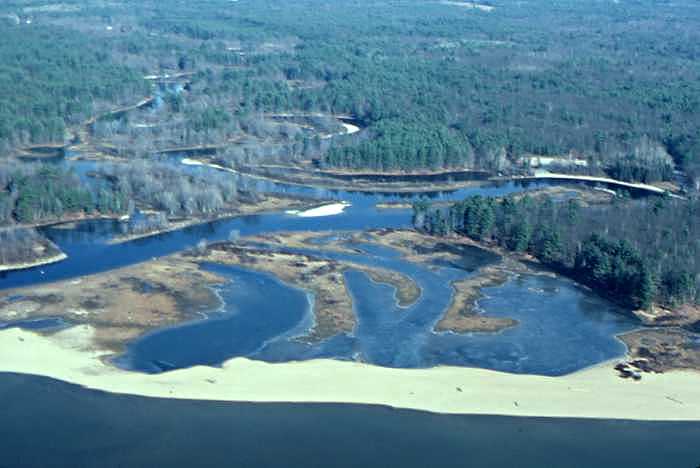
Figure 14. Songo River delta and Songo Beach, Sebago Lake State Park, Naples. These deposits are typical of geological features formed in Maine since the Ice Age.
References
Borns, H. W., Jr., Doner, L. A., Dorion, C. C., Jacobson, G. L., Jr., Kaplan, M. R., Kreutz, K. J., Lowell, T. V., Thompson, W. B., and Weddle, T. K., 2004, The deglaciation of Maine, U.S.A., in Ehlers, J., and Gibbard, P. L. (editors), Quaternary glaciations - extent and chronology, Part II: North America: Elsevier, Amsterdam, p. 89-109.
Caldwell, D. W., 1972, The geology of Baxter State Park and Mt. Katahdin: Maine Geological Survey, Bulletin 12, 57 p.
Davis, R. B., and Jacobson, G. L., Jr., 1985, Late-glacial and early Holocene landscapes in northern New England and adjacent areas of Canada: Quaternary Research, v. 23, p. 341-368.
Dickson, S. M., 1999, The role of storm-generated combined flows in shoreface and inner continental shelf sediment erosion, transport, and deposition: Ph.D. thesis, University of Maine, Orono, 321 p.
Dorion, C. C., Balco, G. A., Kaplan, M. R., Kreutz, K. J., Wright, J. D., and Borns, H. W., Jr., 2001, Stratigraphy, paleoceanography, chronology, and environment during deglaciation of eastern Maine, in Weddle, T. K., and Retelle, M. J. (editors), Deglacial history and relative sea-level changes, northern New England and adjacent Canada: Geological Society of America, Special Paper 351, p. 215-242.
Kaplan, M. R., 1999, Retreat of a tidewater margin of the Laurentide ice sheet in eastern coastal Maine between ca. 14000 and 13000 14C yr B.P.: Geological Society of America, Bulletin, v. 111, no. 4, p. 620-632.
Retelle, M. J., and Weddle, T. K., 2001, Deglaciation and relative sea-level chronology, Casco Bay Lowland and lower Androscoggin River valley, Maine, in Weddle, T. K., and Retelle, M. J. (editors), Deglacial history and relative sea-level changes, northern New England and adjacent Canada: Geological Society of America, Special Paper 351, p. 191-214.
Sirkin, L., 1986, Pleistocene stratigraphy of Long Island, New York, in Cadwell, D. H. (editor), The Wisconsinan stage of the first geological district, eastern New York: New York State Museum, Bulletin 455, p. 6-21.
Stone, B. D., and Borns, H. W., Jr., 1986, Pleistocene glacial and interglacial stratigraphy of New England, Long Island, and adjacent Georges Bank and Gulf of Maine, in Sibrava, V., Bowen, D. Q., and Richmond, G. M. (editors), Quaternary glaciations in the northern hemisphere: Quaternary Science Reviews, v. 5, p. 39-52.
Thompson, W. B., 1982, Recession of the Late Wisconsinan ice sheet in coastal Maine, in Larson, G. J., and Stone, B. D. (editors), Late Wisconsinan glaciation of New England: Kendall/Hunt, Dubuque, p. 211-228.
Thompson, W. B., and Borns, H. W., Jr., 1985, Surficial geologic map of Maine: Maine Geological Survey, scale 1:500,000.
Last updated on October 6, 2005